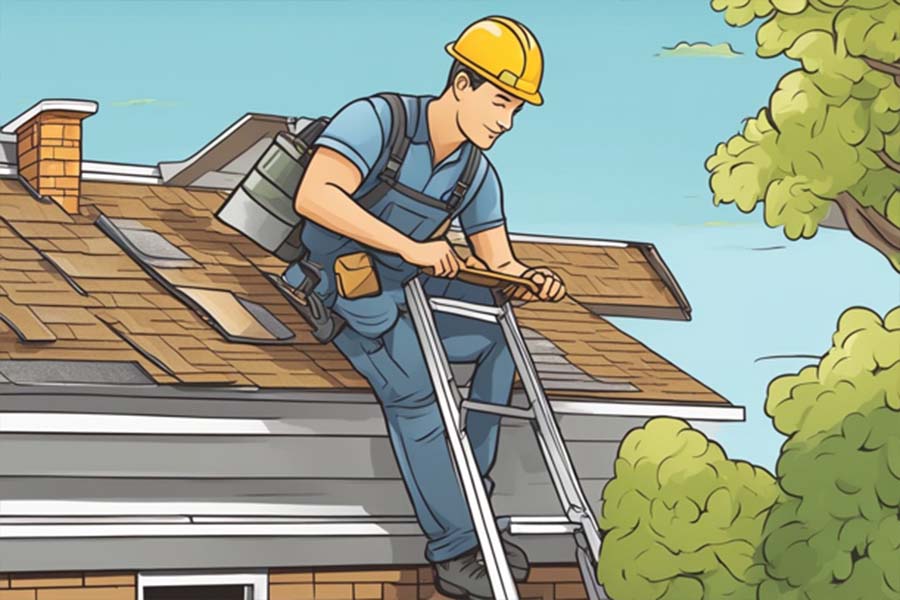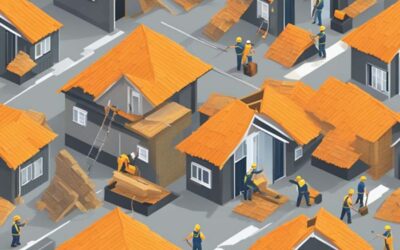Regular roof inspections are essential for maintaining the structural integrity of a building. While many property owners may think that inspections are only necessary after a severe storm, there are other reasons why regular inspections are crucial. Neglecting to inspect your roof regularly can lead to costly damages and repairs in the long run.
One reason why regular roof inspections are necessary is to detect any potential issues before they become major problems. A minor leak or crack in the roof can quickly escalate into a significant issue if left unaddressed. Regular inspections can catch these issues early on, allowing for prompt repairs and preventing more extensive damage. Additionally, inspections can identify areas that may be prone to future problems, allowing for proactive maintenance to prevent damage from occurring in the first place.
The Importance of Regular Roof Inspections
Regular roof inspections are essential for maintaining the integrity of a building’s roof. A roof inspection is a thorough examination of a roof’s condition, including its structure, materials, and overall performance. It is recommended that a roof inspection be conducted at least twice a year, preferably in the spring and fall.
One of the primary reasons for regular roof inspections is to identify and address any potential issues before they become major problems. A small leak or crack in the roof can quickly turn into a major issue if left unchecked. A regular inspection can help catch these issues early, allowing for timely repairs and preventing costly damage to the building.
Another reason for regular roof inspections is to ensure that the roof is performing as it should. A roof that is not functioning properly can result in a variety of problems, including energy loss, water damage, and structural damage. Inspections can help identify any areas where the roof may be underperforming, allowing for necessary adjustments to be made.
Regular roof inspections are also important for maintaining the overall safety and security of a building. A damaged or compromised roof can pose a significant risk to the occupants of a building, as well as anyone in the surrounding area. Inspections can help identify any potential safety hazards, allowing for necessary repairs to be made before an accident occurs.
In conclusion, regular roof inspections are essential for maintaining the integrity, performance, and safety of a building’s roof. By identifying and addressing potential issues early, performing necessary repairs and adjustments, and ensuring that the roof is functioning properly, building owners can help prevent costly damage and ensure the safety and security of their occupants.
Identifying Potential Problems Early
Regular roof inspections can help identify potential problems early, allowing property owners to take preventive measures before they become major issues. Some of the most common problems that can be identified during a roof inspection include:
- Cracks and punctures: These can occur due to normal wear and tear or as a result of storm damage. If left unaddressed, they can lead to leaks and water damage.
- Missing or damaged shingles: These can compromise the integrity of the roof and leave it vulnerable to the elements.
- Clogged gutters and downspouts: These can cause water to pool on the roof, leading to leaks and water damage.
- Improperly sealed flashing: This can allow water to seep into the roof and cause damage to the underlying structure.
By identifying these problems early, property owners can take steps to address them before they become major issues. This can help extend the life of the roof and save money on costly repairs down the road.
In addition to identifying potential problems, regular roof inspections can also help property owners stay on top of routine maintenance tasks, such as cleaning gutters and downspouts, trimming overhanging branches, and removing debris from the roof. By staying on top of these tasks, property owners can help prevent problems from occurring in the first place.
Overall, regular roof inspections are an essential part of maintaining a healthy roof and protecting the property beneath it. By identifying potential problems early and staying on top of routine maintenance tasks, property owners can help ensure that their roof lasts as long as possible and provides reliable protection for years to come.
Extending the Lifespan of Your Roof
Regular roof inspections can help identify minor issues before they become major problems. Addressing these issues early on can extend the lifespan of your roof and save you money in the long run. Here are some tips to help you extend the life of your roof:
Keep Your Roof Clean
Debris such as leaves, branches, and dirt can accumulate on your roof and cause damage over time. Regularly cleaning your roof can help prevent this damage. Use a broom, leaf blower, or pressure washer to remove any debris from your roof.
Trim Overhanging Branches
Overhanging branches can scratch and damage your roof, especially during high winds. Trimming these branches can help prevent this damage and extend the life of your roof.
Inspect Your Attic
Your attic can provide valuable information about the condition of your roof. Inspect your attic for signs of water damage, such as stains or mold. If you notice any issues, contact a professional to address them before they cause further damage.
Address Minor Issues Promptly
Minor issues such as cracked or missing shingles can lead to more serious problems if left unaddressed. Regular inspections can help identify these issues early on, allowing you to address them promptly and prevent further damage.
By following these tips and scheduling regular roof inspections, you can extend the lifespan of your roof and avoid costly repairs down the road.
Maintaining Roof Warranty Requirements
Regular roof inspections are not only essential for detecting storm damage but also for maintaining roof warranty requirements. Most roofing manufacturers require regular inspections and maintenance to keep the warranty valid. Failure to comply with these requirements may result in the warranty being voided, leaving the homeowner responsible for any repairs or replacements.
To ensure compliance with warranty requirements, homeowners should schedule regular roof inspections with a qualified roofing contractor. The contractor should be familiar with the manufacturer’s warranty requirements and be able to provide documentation of the inspections and any necessary repairs.
In addition to inspections, homeowners should also perform routine maintenance on their roofs, such as cleaning gutters and removing debris. Failure to maintain the roof can lead to damage and void the warranty, even if the damage is caused by a covered event such as a storm.
Homeowners should also be aware that some warranties may require specific materials or installation methods. Using non-approved materials or improper installation techniques can also void the warranty. It is important to review the warranty carefully and work with a qualified contractor to ensure compliance.
By maintaining regular inspections and following warranty requirements, homeowners can ensure their roofs remain in good condition and any necessary repairs are covered under warranty.
Ensuring Energy Efficiency
Regular roof inspections not only help to identify potential storm damage but also ensure that the roof is energy-efficient. A poorly maintained roof can lead to significant energy loss, resulting in increased energy bills.
One of the most common causes of energy loss is air leaks. These leaks can occur around vents, chimneys, and other roof penetrations. During a roof inspection, the inspector will check for any air leaks and recommend the necessary repairs.
Another factor that affects energy efficiency is insulation. Insufficient insulation can lead to heat loss during the winter and heat gain during the summer, resulting in increased energy bills. During a roof inspection, the inspector will evaluate the insulation and recommend any necessary upgrades.
In addition to insulation and air leaks, the color of the roof can also affect energy efficiency. A lighter-colored roof reflects sunlight and reduces heat absorption, resulting in lower energy bills. During a roof inspection, the inspector can evaluate the color of the roof and recommend any necessary changes.
Regular roof inspections are essential to ensure that the roof is energy-efficient and to identify any potential issues before they become major problems. By maintaining an energy-efficient roof, homeowners can save money on energy bills and reduce their carbon footprint.
Preventive Measures Against Seasonal Challenges
Regular roof inspections can help identify potential issues before they become major problems. Preventive measures can be taken to address seasonal challenges that can cause damage to a roof. Here are some preventive measures that can be taken to protect your roof:
1. Clean Gutters and Downspouts
Gutters and downspouts play an important role in directing water away from the roof. If they become clogged with debris, they can cause water to back up and damage the roof. Regular cleaning of gutters and downspouts can prevent this from happening.
2. Trim Trees Near the Roof
Trees that are too close to the roof can cause damage during high winds or storms. Falling branches can cause damage to the roof, and overhanging branches can scratch or puncture the roof. Regular trimming of trees near the roof can prevent this type of damage.
3. Inspect and Repair Flashing
Flashing is the material that is used to seal joints and seams on the roof. It can become damaged over time and cause leaks. Regular inspections of flashing can identify any areas that need repair before they cause damage to the roof.
4. Check for Signs of Animal Damage
Animals such as birds, squirrels, and raccoons can cause damage to a roof. They may scratch or chew through roofing materials or create nests that can cause water damage. Regular inspections can identify any signs of animal damage before it becomes a major problem.
By taking these preventive measures, homeowners can protect their roofs from seasonal challenges and extend the life of their roof. Regular roof inspections can help identify potential issues before they become major problems, saving homeowners time and money in the long run.
Components of a Comprehensive Roof Inspection
Regular roof inspections are crucial for maintaining the integrity and longevity of a roof. A comprehensive roof inspection involves examining various components of the roof to identify any potential issues that may require repair or replacement. Here are the four main components of a comprehensive roof inspection:
Structural Inspection
The structural inspection involves examining the roof’s support structure, including the trusses, rafters, and beams. The inspector checks for any signs of damage, such as cracks or splits, that could compromise the roof’s stability. They also look for any signs of sagging or unevenness, which could indicate a problem with the roof’s load-bearing capacity.
Material Inspection
The material inspection involves examining the roof’s surface materials, such as shingles, tiles, or metal panels. The inspector checks for any signs of wear and tear, such as cracks, missing pieces, or rust. They also look for any signs of damage caused by weather events, such as hail or wind damage.
Interior Inspection
The interior inspection involves examining the roof’s underside, including the attic and ceiling. The inspector checks for any signs of water damage, such as stains or mold growth, which could indicate a leak in the roof. They also look for any signs of pests, such as rodents or insects, which could cause damage to the roof’s structure.
Workmanship Inspection
The workmanship inspection involves examining the roof’s installation and maintenance history. The inspector checks for any signs of poor workmanship, such as improperly installed flashing or vents. They also look for any signs of inadequate maintenance, such as clogged gutters or debris buildup on the roof.
In conclusion, a comprehensive roof inspection involves examining various components of the roof to identify any potential issues that may require repair or replacement. By conducting regular roof inspections, homeowners can ensure the safety and longevity of their roof.
When to Schedule Roof Inspections
Regular roof inspections are essential for maintaining the integrity of your roof and preventing potential damage. But when should you schedule these inspections?
The frequency of your roof inspections will depend on a few factors, such as the age of your roof, the type of roofing material, and the climate in your area. As a general rule, it’s recommended to have a professional roof inspection at least once a year.
However, if you live in an area with harsh weather conditions or frequent storms, you may want to consider scheduling inspections more frequently. Additionally, if your roof is older or has experienced previous damage, it’s important to have it inspected more often to catch any potential issues early on.
It’s also important to schedule a roof inspection after any major weather events, such as hailstorms or heavy winds. Even if you don’t see any visible damage, a professional inspection can help identify any underlying issues that may have been caused by the storm.
In summary, scheduling regular roof inspections can help prevent potential damage and prolong the life of your roof. The frequency of these inspections will depend on various factors, but as a general rule, it’s recommended to have a professional inspection at least once a year.
Professional vs. DIY Roof Inspections
When it comes to roof inspections, homeowners may be tempted to perform them on their own to save expenses. However, it is important to understand the differences between professional and DIY inspections.
Professional roof inspections are conducted by licensed and experienced roofing professionals. They have the necessary knowledge, equipment, and tools to thoroughly inspect a roof and identify any potential issues. They can also provide recommendations on maintenance and repairs to ensure the longevity of the roof.
On the other hand, DIY inspections may not be as thorough or accurate as professional inspections. Homeowners may not have the necessary knowledge or experience to identify all potential issues, which could lead to costly repairs down the line. Additionally, DIY inspections may not be as safe, as homeowners may not have the proper safety equipment or training to climb on a roof.
In summary, while DIY inspections may seem like a cost-effective solution, they may not provide the same level of accuracy and safety as professional inspections. Homeowners should consider hiring a licensed roofing professional to conduct regular inspections to ensure the longevity and safety of their roof.
Understanding the Inspection Report
When a professional roofing inspector completes an inspection, they will provide a report outlining their findings. This report is a detailed document that provides a comprehensive overview of the condition of the roof. It is important to understand the contents of the report to make informed decisions about any necessary repairs or maintenance.
The report will typically include a description of the roof’s current condition, highlighting any areas of concern or damage. It may also include recommendations for repairs or maintenance to prevent further damage and extend the life of the roof.
The report may use technical terms and industry jargon, which can be confusing for those who are not familiar with the roofing industry. However, a good inspector will take the time to explain any unfamiliar terms and answer any questions that the property owner may have.
It is important to review the report carefully and ask any questions to ensure that you fully understand the findings. This will help you make informed decisions about any necessary repairs or maintenance, and ensure that your roof remains in good condition for years to come.
Overall, understanding the inspection report is essential for any property owner who wants to maintain a safe and secure roof. By working with a professional roofing inspector and reviewing the report carefully, property owners can ensure that their roof remains in good condition and avoid costly repairs in the future.
The Economic Benefits of Regular Inspections
Regular roof inspections not only help prevent costly damage from storms, but they also provide economic benefits for homeowners and businesses. By identifying and addressing issues early on, regular inspections can save money in the long run.
One economic benefit of regular inspections is that they can extend the lifespan of a roof. By catching small issues before they turn into major problems, roofs can last longer and require fewer repairs or replacements over time. This can save homeowners and businesses thousands of dollars in replacement costs.
Another economic benefit of regular inspections is that they can help improve energy efficiency. Inspections can identify areas where insulation or ventilation may be lacking, which can cause energy waste and higher utility bills. By addressing these issues, homeowners and businesses can save money on their energy costs.
Regular inspections can also help prevent liability issues and potential lawsuits. If a roof is not properly maintained and someone is injured as a result, the homeowner or business owner could be held liable. Regular inspections can identify potential hazards and allow for repairs to be made before accidents occur, potentially saving thousands of dollars in legal fees and settlements.
In summary, regular roof inspections provide economic benefits by extending the lifespan of a roof, improving energy efficiency, and preventing liability issues. Homeowners and businesses can save money in the long run by investing in regular inspections and addressing issues early on.




0 Comments